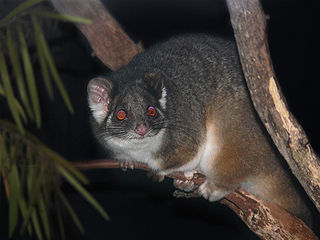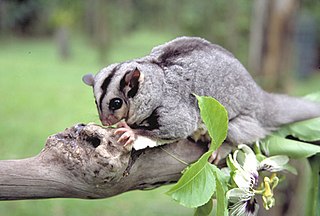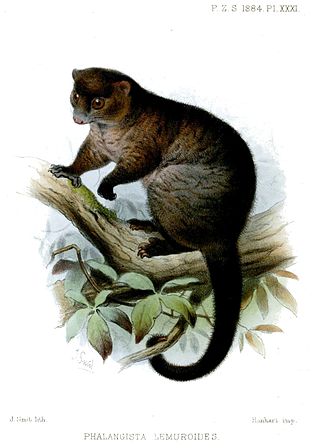
The sugar glider is a small, omnivorous, arboreal, and nocturnal gliding possum. The common name refers to its predilection for sugary foods such as sap and nectar and its ability to glide through the air, much like a flying squirrel. They have very similar habits and appearance to the flying squirrel, despite not being closely related—an example of convergent evolution. The scientific name, Petaurus breviceps, translates from Latin as "short-headed rope-dancer", a reference to their canopy acrobatics.

Phalangeriformes is a paraphyletic suborder of about 70 species of small to medium-sized arboreal marsupials native to Australia, New Guinea, and Sulawesi. The species are commonly known as possums, gliders, and cuscus. The common name "possum" for various Phalangeriformes species derives from the creatures' resemblance to the opossums of the Americas. However, although opossums are also marsupials, Australasian possums are more closely related to other Australasian marsupials such as kangaroos.

Diprotodontia is the largest extant order of marsupials, with about 155 species, including the kangaroos, wallabies, possums, koala, wombats, and many others. Extinct diprotodonts include the hippopotamus-sized Diprotodon, and Thylacoleo, the so-called "marsupial lion".

Petauridae is a family of possums containing 11 species: four species of trioks and striped possum, six species of wrist-winged glider, and Leadbeater's possum, which has only vestigial gliding membranes. Most of the wrist-winged gliders are native to Australia, whereas most of the striped possums to New Guinea, but some members of each group are found on both sides of the Torres Strait. Leadbeater's possum is endemic to Victoria, Australia.

The squirrel glider is a nocturnal gliding possum. The squirrel glider is one of the wrist-winged gliders of the genus Petaurus.

The genus Petaurus contains flying phalangers or wrist-winged gliders, a group of arboreal possums native to Australia, New Guinea, and surrounding islands. There are eight species: the sugar glider, savanna glider, Krefft's glider, squirrel glider, mahogany glider, northern glider, yellow-bellied glider and Biak glider.

The common ringtail possum is an Australian marsupial.
There are many different types of gliding possum, sometimes referred to as volplane possum, flying phalangers, or simply as gliders:

The mahogany glider is an endangered gliding possum native to a small region of coastal Queensland in Australia.

The striped possum or common striped possum is a member of the marsupial family Petauridae. It is found mainly in New Guinea. The species is black with three white stripes running head to tail, and its head has white stripes that form a 'Y' shape. It is closely related to the sugar glider, and is similar in appearance.

The lemuroid ringtail possum, also known as the lemur-like ringtail possum or the brushy-tailed ringtail, is a truly singular member of the ringtail possum group. It was once thought that they were greater gliders ; Hemibelideus literally translates as "half-glider". Named for their facial characteristics visually similar to the unrelated primate lemurs, with short snouts, large, forward-facing eyes and small ears, they are similar to other gliding possums in their musculo-skeletal adaptations to accommodate a leaping lifestyle. Their long, prehensile tail is a further adaptation to their arboreal habitat.

The greater gliders are three species of large gliding marsupials in the genus Petauroides, all of which are found in eastern Australia. Until 2020 they were considered to be one species, Petauroides volans. In 2020 morphological and genetic differences, obtained using diversity arrays technology, showed there were three species subsumed under this one name. The two new species were named Petauroides armillatus and Petauroides minor.

Corymbia intermedia, commonly known as pink bloodwood, is a species of medium to tall tree that is endemic to north-eastern Australia. It has rough, tessellated bark on the trunk and branches, flower buds in groups of seven, white flowers and oval to barrel-shaped fruit.

The mountain brushtail possum, or southern bobuck, is a nocturnal, semi-arboreal marsupial of the family Phalangeridae native to southeastern Australia. It was not described as a separate species until 2002.

Petauroidea is a superfamily of marsupials from Australia and New Guinea. It is part of the suborder Phalangeriformes within the order Diprotodontia, which also includes, among others, wombats, kangaroos, cuscuses. The superfamily Phalangeroidea, including cuscuses and brushtail possums and pygmy possums, is the immediate sister group of the Petauroidea.

Krefft's glider is a species of arboreal nocturnal gliding possum, a type of small marsupial. It is native to most of eastern mainland Australia and has been introduced to Tasmania. Populations of Petaurus from New Guinea and Indonesia previously classified under P. breviceps are also tentatively classified under P. notatus by the American Society of Mammalogists, but likely represent a complex of distinct species. As most captive gliders referred to as "sugar gliders" in at least the United States are thought to originate from West Papua, this likely makes them Krefft's gliders, at least tentatively.



















